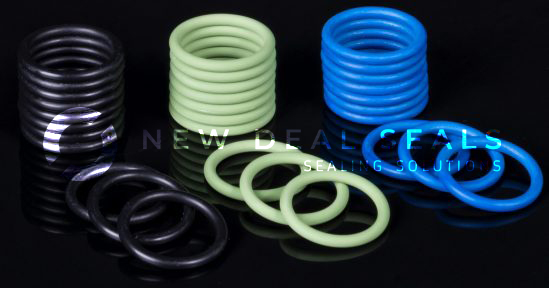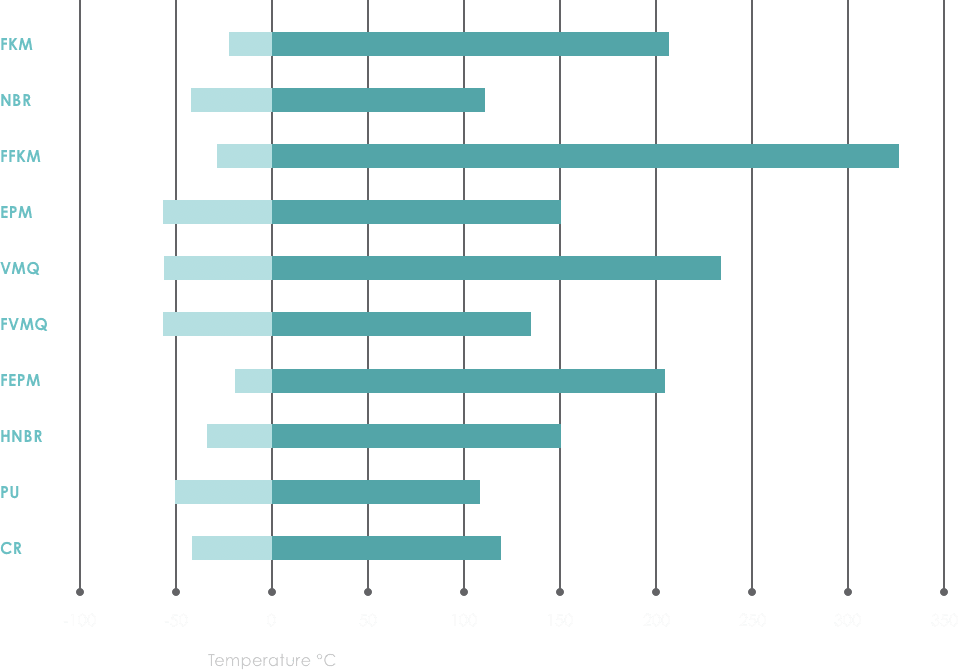ELASTOMER COMPOUNDS
Rubber is known for its memory. Rubber has the tendency to move back to its original shape after being deformed, making it an excellent sealing material for static and light dynamic applications.

FKM (Viton®)
Fluorcarbon
Also referred to as fluoroelastomers, fluorocarbon compounds are thermoset elastomers containing fluorine. Fluorocarbons make excellent general purpose O-rings.
Temp range: -25° tot +204° C
Relative cost: •••••
NBR,
Nitrile
Nitrile rubber is the most commonly used elastomer for O-rings and other sealing devices. Also known as Buna N, nitrile is a copolymer of butadiene and acrylonitrile (ACN).
Temp range: -40° tot +108° C
Relative cost: •••••
FFKM (Fluorezi®) Perfluoroelastomer
FFKM has a fluorine content of more than 71%. These perfluoroelastomers with a higher fluorine content have a better chemical and heat resistance than standard fluoroelastomers do.
Temp range: -30° tot +325° C
Relative cost: •••••
EPM, EPDM, Ethylene Propylene
Ethylene propylene is a copolymer of ethylene and propylene (EPM), or, in some cases, a terpolymer due to the addition of a diene monomer (EPDM).
Temp range: -55° tot +150° C
Relative cost: •••••
VMQ, Silicone
Silicones are very resistant to oxygen, ozone, and UV light. They also have great flexibility retention and low compression set.
Temp range: -25° tot +204° C
Relative cost: •••••
FVMQ, Fluorosilicone
Fluorosilicone is the common name for fluorovinylmethyl silicone rubber. Fluorosilicones combine the best properties of fluorocarbons and silicones.
Temp range: -55° tot +180° C
Relative cost: •••••
FEPM, Tetrafluoroethylene Propylene
The FEPM designation was originally directed at copolymers of tetrafluoroethylene (TFE) and propylene (P). TFE/P provides a unique combination of chemical, heat, and electrical resistance.
Temp range: -20° tot +204° C
Relative cost: •••••
HNBR, Hydrogenated Nitrile
Hydrogenated nitrile results from the hydrogenation of standard nitrile. Hydrogenation is the process of adding hydrogen atoms to the butadiene segments.
Temp range: -30° tot +150° C
Relative cost: •••••
PU, Polyurethane
Polyurethane is the toughest, most extrusion-resistant, and most abrasion-resistant of all elastomeric sealing materials.
Temp range: -50° tot +108° C
Relative cost: •••••
CR, Chloroprene
Chemically known as polychloroprene but often referred to by the trade name Neoprene®, chloroprene was one of the first synthetic materials developed as an oil-resistant substitute for natural rubber
Temp range: -40° tot +121° C
Relative cost: •••••
TEMPERATURE RESISTANCE GUIDE

CHEMICAL RESISTANCE GUIDE
| FKM | NBR | FFKM | EPDM | VMQ | FVMQ | FEPM | HNBR | |
|---|---|---|---|---|---|---|---|---|
| Inorganic acids | B | C | A | B | C | C | A | C |
| Organic acids | C | B | A | B | B | D | C | B |
| Alkalis | B | B | A | D | B | B | A | B |
| Amines | D | D | A | B | A | D | A | A |
| Steam | B | D | A | B | B | C | A | C |
| Ketones | D | D | A | B | C | D | D | D |
| Esters | D | D | A | B | B | D | D | D |
| Ethers | D | D | A | D | A | A | D | A |
| Aldehydes | D | C | A | C | B | D | D | D |
| Alcohols | B | B | A | C | A | A | A | A |
| Aliphatic Hydrocarbons | A | C | A | D | D | A | B | A |
| Aromatic Hydrocarbons | A | C | A | D | D | C | D | D |
| Sour gas | B | C | A | D | C | C | A | C |
| Lubricents | A | B | A | B | A | A | A | A |
| Fluorinated fluids | D | – | C | – | D | C | D | A |
- A = Excellent
- B = Good
- C = Average
- D = Not recommended
CONTACT FORM
We believe in the quality of our products and service. Fill out the form on the right-hand side and we will contact you shortly. Or you can use our product request form here.
NewDealSeals B.V.
+31 (0) 226 362 233
Boezemschop 8, Breekland, 1724 BJ Oudkarspel, The Netherlands



